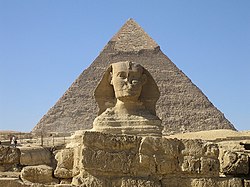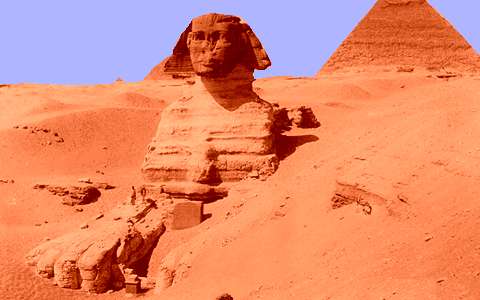 pyramid and sphinx of egypt
pyramid and sphinx of egypt
Here are some interesting Sphinx facts to know before your tour of the Giza necropolis. They will help you appreciate even more this fabulous Egypt icon.
pyramid and sphinx of egyptThe Great Sphinx of Egypt is part of the funerary complex of the Egyptian pharaoh Khafre, builder of the second Giza Pyramid, who reigned between 2558 and 2532 B.C. more than 4,000 years ago.
The face of the Sphinx is believed to represent Khafre, which makes it the oldest large-scale royal portrait known.
The Great Sphinx of Egypt is the largest free-standing sculpture. It is 57 metres (260 feet) long, 6 m (20 ft) wide, and has a height of 20 m (65 ft)
It was carved from a single outcrop of limestone, making it the largest single-stone statue in the world. The layers of the limestone of the Giza plateau from which the Sphinx is carved are different in strength. The stone of the first two layers up to its chest is of poor quality, so the ancient sculptors added more solid blocks to the lower parts and carved the details. The head, with its nemes headcloth, uraeus, and false beard is carved directly on the stronger layer of the mother rock.
The Great Sphinx faces due east, in salutation of the rising sun.
A millenium after it was built, the Sphinx was covered in sand up to its neck. Around 1400 BC, Thutmose IV of the New Kingdom claimed his legitimacy to the throne of Egypt by clearing the sands. This he did after falling asleep under its shadow and receiving a message to do so from Re-Harmachis through the Sphinx itself. Thutmose IV had a granite stela known as the Dream Stela placed between the paws, which travelers can see on a tour of the Sphinx. He had many of the fallen Old Kingdom blocks replaced and also built a huge mud-brick wall in the shape of a large cartouche to protect the statue from the wind and stop erosion.
picture of the great sphinx The Sphinx was finally dug out in its entirety in 1925.
Another curious Sphinx fact: The Western name "Sphinx" was given to it in antiquity based on the legendary Greek mythology sphinx, a creature with the body of a lion, the head of a woman and the wings of a bird, though Egyptian sphinxes have the head of a man.
Sphinx facts about the missing nose: A legend that the nose of the Great Sphinx was broken off by a cannon ball fired by Napoleon's soldiers still survives, as do diverse variants indicting British troops, Mamluks, and others. However, sketches of the Sphinx by Frederick Lewis Norden made in 1737 and published in 1755 already illustrate the Sphinx without a nose. The Egyptian historian al-Maqrizi, writing in the fifteenth century, attributes the vandalism to Muhammad Sa'im al-Dahr, a Sufi fanatic from the khanqah of Sa'id al-Su'ada. In 1378, upon finding the Egyptian peasants making offerings to the Sphinx in the hope of increasing their harvest, Sa'im al-Dahr was so outraged that he destroyed the nose. Al-Maqrizi describes the Sphinx as the "Nile talisman" on which the locals believed the cycle of inundation depended.
Sphinx Mythology: The Great Sphinx was believed to stand as a guardian of the Giza Plateau, where it faces the rising sun. It was the focus of solar worship in the Old Kingdom, centered in the adjoining temples built around the time of its probable construction. Its animal form, the lion, has long been a symbol associated with the sun in ancient Near Eastern civilizations. Images depicting the Egyptian king in the form of a lion smiting his enemies appear as far back as the Early Dynastic Period of Egypt. During the New Kingdom, the Sphinx became more specifically associated with the god Hor-em-akhet (Greek Harmachis) or Horus at the Horizon, which represented the Pharaoh in his role as the Shesep ankh of Atum (living image of Atum). A temple was built to the northeast of the Sphinx by King Amenhotep II, nearly a thousand years after its construction, dedicated to the cult of Horemakhet.
Riddle of the Sphinx: The Great Sphinx is one of the world's largest and oldest statues, yet basic Sphinx facts about it such as the real-life model for the face, when it was built, and by whom, are debated. These questions have collectively earned the title "Riddle of the Sphinx", a nod to its Greek namesake, although this phrase should not be confused with the original Greek Oedipus and riddle Sphinx legend.










